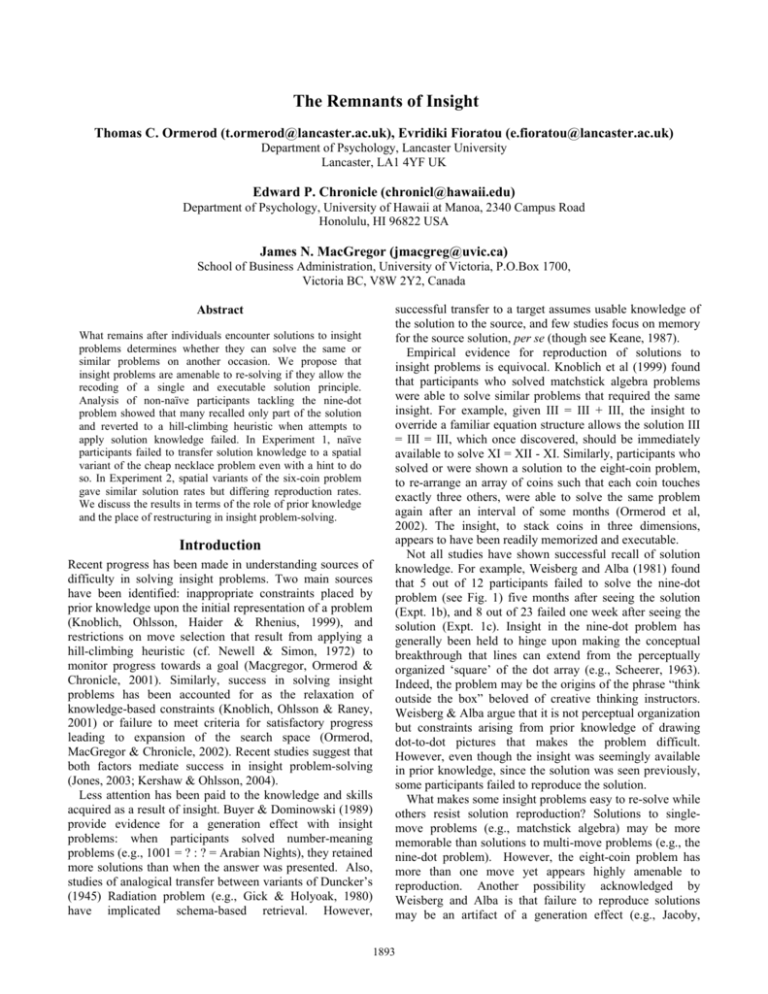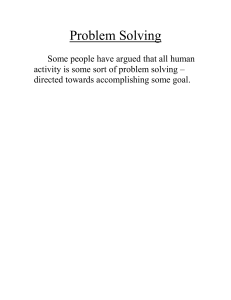The Remnants of Insight
advertisement

The Remnants of Insight Thomas C. Ormerod (t.ormerod@lancaster.ac.uk), Evridiki Fioratou (e.fioratou@lancaster.ac.uk) Department of Psychology, Lancaster University Lancaster, LA1 4YF UK Edward P. Chronicle (chronicl@hawaii.edu) Department of Psychology, University of Hawaii at Manoa, 2340 Campus Road Honolulu, HI 96822 USA James N. MacGregor (jmacgreg@uvic.ca) School of Business Administration, University of Victoria, P.O.Box 1700, Victoria BC, V8W 2Y2, Canada Abstract What remains after individuals encounter solutions to insight problems determines whether they can solve the same or similar problems on another occasion. We propose that insight problems are amenable to re-solving if they allow the recoding of a single and executable solution principle. Analysis of non-naïve participants tackling the nine-dot problem showed that many recalled only part of the solution and reverted to a hill-climbing heuristic when attempts to apply solution knowledge failed. In Experiment 1, naïve participants failed to transfer solution knowledge to a spatial variant of the cheap necklace problem even with a hint to do so. In Experiment 2, spatial variants of the six-coin problem gave similar solution rates but differing reproduction rates. We discuss the results in terms of the role of prior knowledge and the place of restructuring in insight problem-solving. Introduction Recent progress has been made in understanding sources of difficulty in solving insight problems. Two main sources have been identified: inappropriate constraints placed by prior knowledge upon the initial representation of a problem (Knoblich, Ohlsson, Haider & Rhenius, 1999), and restrictions on move selection that result from applying a hill-climbing heuristic (cf. Newell & Simon, 1972) to monitor progress towards a goal (Macgregor, Ormerod & Chronicle, 2001). Similarly, success in solving insight problems has been accounted for as the relaxation of knowledge-based constraints (Knoblich, Ohlsson & Raney, 2001) or failure to meet criteria for satisfactory progress leading to expansion of the search space (Ormerod, MacGregor & Chronicle, 2002). Recent studies suggest that both factors mediate success in insight problem-solving (Jones, 2003; Kershaw & Ohlsson, 2004). Less attention has been paid to the knowledge and skills acquired as a result of insight. Buyer & Dominowski (1989) provide evidence for a generation effect with insight problems: when participants solved number-meaning problems (e.g., 1001 = ? : ? = Arabian Nights), they retained more solutions than when the answer was presented. Also, studies of analogical transfer between variants of Duncker’s (1945) Radiation problem (e.g., Gick & Holyoak, 1980) have implicated schema-based retrieval. However, successful transfer to a target assumes usable knowledge of the solution to the source, and few studies focus on memory for the source solution, per se (though see Keane, 1987). Empirical evidence for reproduction of solutions to insight problems is equivocal. Knoblich et al (1999) found that participants who solved matchstick algebra problems were able to solve similar problems that required the same insight. For example, given III = III + III, the insight to override a familiar equation structure allows the solution III = III = III, which once discovered, should be immediately available to solve XI = XII - XI. Similarly, participants who solved or were shown a solution to the eight-coin problem, to re-arrange an array of coins such that each coin touches exactly three others, were able to solve the same problem again after an interval of some months (Ormerod et al, 2002). The insight, to stack coins in three dimensions, appears to have been readily memorized and executable. Not all studies have shown successful recall of solution knowledge. For example, Weisberg and Alba (1981) found that 5 out of 12 participants failed to solve the nine-dot problem (see Fig. 1) five months after seeing the solution (Expt. 1b), and 8 out of 23 failed one week after seeing the solution (Expt. 1c). Insight in the nine-dot problem has generally been held to hinge upon making the conceptual breakthrough that lines can extend from the perceptually organized ‘square’ of the dot array (e.g., Scheerer, 1963). Indeed, the problem may be the origins of the phrase “think outside the box” beloved of creative thinking instructors. Weisberg & Alba argue that it is not perceptual organization but constraints arising from prior knowledge of drawing dot-to-dot pictures that makes the problem difficult. However, even though the insight was seemingly available in prior knowledge, since the solution was seen previously, some participants failed to reproduce the solution. What makes some insight problems easy to re-solve while others resist solution reproduction? Solutions to singlemove problems (e.g., matchstick algebra) may be more memorable than solutions to multi-move problems (e.g., the nine-dot problem). However, the eight-coin problem has more than one move yet appears highly amenable to reproduction. Another possibility acknowledged by Weisberg and Alba is that failure to reproduce solutions may be an artifact of a generation effect (e.g., Jacoby, 1893 1978). In other words, where participants fail to re-solve, they are typically shown the solution after failing to discover it. However, as Ormerod et al (2002) found, even when participants are shown rather than generate a solution to the eight-coin problem, it remains equally and absolutely reproducible after long delays. Experiment 2 further tests these hypotheses using isomorphic and multi-step insight problems that appear to differ in ease of reproduction. Another explanation of failure to reproduce a seen solution is that some participants simply forget the insight. Weisberg and Alba report that, of 23 participants in Experiment 1c, 10 solved on the first attempt. Of the remaining 13, 6 went outside the square on their first attempt, and 5 of these went on to solve. The 7 who did not go outside the square on their first attempt all failed to solve. Weisberg and Alba suggest that these participants simply forgot the insight to extend lines beyond the dot array. However, in this experiment, participants were given 36 attempts, and Weisberg and Alba do not report whether these 7 participants continued to draw solution attempts within the array on subsequent attempts. The forgetting explanation begs the question as to why some insights are remembered while others are lost. Weisberg and Alba provide example protocols in which a failing participant recalled the ‘going outside’ insight but could not execute it, and a successful participant who remembered an arrow shape but who took a number of trials to “remember exactly how the lines went” (p. 177). Thus, forgetting alone may not determine re-solving. The knowledge required to reproduce a solution to the nine-dot problem is complex, involving not only the ‘going outside’ concept but also an ‘arrow shape’ concept, and perhaps also a procedural execution concept (e.g., “start from the bottom right and draw a diagonal line...”). When partial knowledge (of the arrow shape, going outside, or the order of lines) fails to yield a solution, one of two things might happen. A participant might persevere with attempts to apply that knowledge. Alternatively, they might, at least temporarily, abandon their efforts to find a solution by applying remembered solution knowledge, and instead seek a solution through other means. We have previously argued that naïve participants attempt to solve insight problems by hill-climbing, selecting moves that make the most progress towards a hypothesized goal state (MacGregor et al, 2001). Often, the moves that appear to make the most progress lie off the solution path, which explains why problems like the nine-dot are extremely difficult. We suggest that non-naïve participants may return (a) (b) to hill-climbing when attempts to apply prior knowledge of solution principles do not bear immediate fruit. In this paper, we report three sets of data. First, we analyze performance of non-naïve participants from studies by MacGregor et al (2001). As well as replicating Weisberg and Alba (1981) with a larger sample, we examined the repeated attempts made by non-solvers as a test of the hypothesis that participants switch between applications of prior knowledge and hill climbing in attempts to reproduce a solution. We also present two new experiments. In Experiment 1, participants attempted variants of the Cheap Necklace problem (e.g., Silviera, 1971). The experiment investigated whether participants were able to implement and subsequently reproduce a conceptual insight into the solution. In Experiment 2, participants solved two variants of the six-coin problem (Chronicle, MacGregor & Ormerod, 2004). The experiment investigated the effects of providing different spatial layouts for structurally isomorphic problems upon production and reproduction of solutions. Analysis of non-naïve nine-dot data The data came from Experiments 4 and 5 of MacGregor et al (2001), in which participants attempted a solution to the nine-dot problem from a given first line. The experiments tested a prediction that a diagonal line remaining within the array would be more facilitative than a horizontal line that extends outside the array (see Fig. 1b). This prediction was confirmed with solution rates of 47% versus 28% (Expt. 4) and 65% versus 43% (Expt. 5). We interpreted the results as evidence for progress monitoring: the diagonal version leads to an earlier failure to find moves that make sufficient progress than the horizontal version, which in turn leads participants to increase the search space for possible solutions. The results are inconsistent with perceptual organization or prior knowledge blocking moves outside the array, since the horizontal line extends beyond the array to a non-dot point. Prior to experimental trials, participants received ten trials consisting of the standard nine-dot problem, and it is these data we consider here. Method (c) Participants Data were analyzed from 24 out of 134 participants in Experiment 4 and 16 out of 103 participants in Experiment 5 (MacGregor et al, 2001) who indicated in a post-experiment questionnaire that they had seen the ninedot problem before. Participants were members of the general public attending an open day in Experiment 4 and (d) (e) Figure 1. The nine-dot problem (a) and its solution (b). The task is to draw four straight lines without removing pen from paper to cancel each of the dots. The solid lines in (b) illustrate the alternative first lines given by Macgregor et al (2001, Expts. 4 & 5). Also shown are examples that illustrate arrow shape (c), going outside (d) and within (e) attempts. 1894 undergraduates in Experiment 5. Responses were collected without identifiers; hence, gender ratio and mean age of the participant group are not known. Design and procedure All participants took part under the same conditions for trials with the standard problem. Each participant received a booklet at the point of entry to the lecture theatre, containing the stimuli and task instructions. On each of the first ten pages, the standard nine-dot problem was presented, and participants drew a solution attempt on each page. Participants were given 30s per attempt, after which they were told to turn the page onto the next trial. Solution Arrow 12 Outside Within 10 No attempt 8 6 4 2 0 1 2 3 4 5 6 7 8 9 10 Figure 2. Frequency of each response category across ninedot problem trial by non-naïve participants. Results and discussion No naïve participants solved the standard nine-dot problem in either of the experiments. Seven of the non-naïve participants did not make any response attempt on any trial and were not analyzed further. The responses of the remaining 33 non-naïve participants were classified into one of five categories: a correct solution, ‘arrow shape’, ‘going outside’, ‘within’, and no attempt. All responses fell unambiguously into one of these five categories. The frequencies of each response category across trials are illustrated in Figure 2. There are two observations of immediate note. First, consistent with the results of Weisberg and Alba (1981), 10 participants solved on their first attempt and 7 on their second attempt, but a further 16 failed to solve within two attempts, and 11 failed to solve within the 10 available attempts. Thus, the failure of a substantial proportion of non-naïve participants to reproduce the solution to the nine-dot problem is confirmed. Second, the two most common response categories of non-solvers were ‘going outside’ and ‘within’. The 16 participants who failed to solve within two trials were further classified according to whether their attempts were consistently going outside or within (i.e., where at least 8 trials were of one type) or whether their attempts were mixed (i.e., participants who produced at least three going outside and three within trials). The frequencies of each category were 2 ‘within’, 5 ‘going outside’ and 8 ‘mixed’. These results are inconsistent with participants forgetting the insight to go outside the square. Instead, it seems that participants were able to recall the insight, but were unable to use it to reconstruct the solution. Many participants oscillated between applying prior knowledge and using hillclimbing to select moves within the dot array. There is also a slight indication that remembering the arrow shape is more predictive of solution than the ‘going outside’ insight, since all three participants who made an arrow attempt on the first trial solved on the second trial. However, numbers are too small to tell whether this effect is reliable. The failure of some participants to use prior knowledge of the solution successfully points to the complexity of the knowledge needed to reproduce the solution reliably. The difficulty of reproducing a solution to the nine-dot problem seems to arise because the knowledge needed to solve cannot be coded as a single executable solution concept. 14 This contrasts with problems such as matchstick algebra and the eight-coin problem where participants can readily reproduce solutions from single concepts such as ‘three-part equation’ or ‘stack coins in three dimensions’. Experiment 1 1895 Can reproduction be enhanced by presenting participants with a conceptual hint to the nature of the solution? Figure 3 illustrates the Cheap Necklace problem. The task is notoriously difficult, with solution rates of 10% or less (Silviera, 1971; Murray, 2005). At least part of the difficulty stems from a requirement to break one chain length in its entirety, reducing the number of lengths that must be joined. It is not immediately clear how prior knowledge might impose a constraint to block discovery of this possibility. However, breaking up a whole length seems to take participants further away from the solution requirement of forming a complete chain. Fioratou (2005) found that the most common moves involved joining lengths A to B, B to C, and so on, a sequence that seems to maximize progress but leads inevitably to failure. We presented the problem with a conceptual hint to the solution. We hypothesized that, if prior knowledge imposes inappropriate constraints, or if participants lack knowledge that might help them consider reducing the number of lengths, this hint should help them solve the problem. In contrast, if hill-climbing dominates performance, then the hint will have little effect on solution rates. The experiment also explored solution transfer to a problem variant, also shown in Figure 3. Fioratou (2005) found that participants shown the solution to the standard problem were able reliably to re-solve it a week later. Solution reproduction may be based on recall of a conceptual insight. Alternatively, it might reflect the recall of a procedural sequence. The problem variant tested these alternatives: transfer of a conceptual insight should lead to success, whereas transfer of procedural knowledge would not. We also hypothesized that, if the activation of relevant prior knowledge determines insight performance, participants who received the conceptual hint would be more likely to solve the problem variant. Figure 3. The cheap necklace problem (left), variant (centre) and goal state (right). The task is to form a necklace from the lengths at a cost of no more than 15 cents. It costs 2 cents to open a link and 3 cents to close a link. Method Participants Fifty members of the general public attending a university open day took part in the experiment. Responses were collected without identifiers; hence, gender ratio and mean age of the participant group are not known. Design and procedure Participants were assigned to one of two groups, one receiving the hint, the other serving as a control. Participants received booklets containing stimuli and instructions, and were given 5 minutes to solve the standard problem. They were then shown the solution to the problem as a sequence of link breaks and joins. They then spent four minutes on a filler task (Wason’s, 1966, selection task). They were then given 5 minutes to solve the problem variant. Prior to the variant, they received the instruction “Information about the first problem you saw may prove useful in solving the next problem”. Then they were given two minutes to re-solve the standard problem. Participants in the hint group received additional instructions with the first problem: “Hint – sometimes it is necessary to destroy in order to create. In solving some problems, you need to go backwards before you can go forwards”. This wording was chosen to avoid reference to breaking or undoing links. The hint was repeated on presenting the problem variant. Finally, they were asked to write a sentence describing their understanding of the hint. Results and discussion Three participants from each group provided no responses in their booklet. Of the remaining 44 participants, one in the hint group and two in the control group solved the standard problem. Failure to use a solution-relevant hint has been found before. Chronicle, Ormerod & MacGregor (2001) found that superimposing the nine-dot problem over shading in the shape of the solution gave little facilitation, even when its relevance was drawn to participants’ attention. To examine a possibility that participants did not understand the hint, we inspected their hint descriptions. Five participants gave no description, four gave metaphors (e.g., “you can’t make an omelet without breaking eggs”), six restated the hint in the same words, three gave irrelevant or incorrect re-descriptions (e.g., “You need to work hard to find the solution), and four re-stated the hint with essentially the same meaning (e.g., “You should undo some of the required product before you can finish”). These descriptions are open to interpretation, but we suggest that many participants understood and remembered the intended meaning of the hint yet were unable to apply it. Five participants in the hint group and six in the control group solved the problem variant. Although solution rates are slightly higher than for the standard problem, most participants failed to transfer solution knowledge to the problem variant. This failure is surprising given reports of successful analogical transfer between superficially different but conceptually similar problems, at least when participants are told of the analogous nature of source and target problems (e.g., Gick & Holyoak, 1980). Here, the problems had both conceptual and superficial similarities, and participants were cued to their relatedness. The possibility that participants forgot the solution to the first problem can be ruled out: all 44 participants were able to re-solve the standard problem within two minutes. The results indicate that the knowledge retained of the solution to the cheap necklace problem, which is sufficient to reproduce a solution to precisely the same problem, is purely procedural (i.e., a sequence of steps). Somewhat disappointingly, the ‘destroy in order to create’ hint does not help participants to extract a usable conceptual representation of the solution. This is surprising, since the cheap necklace problem is upheld as an archetypal insight problem. Yet here, even when participants see the solution and its properties are described, they do not get the insight. A simple change in perceptual layout led to failure to solve a variant of the cheap necklace problem, even when the conceptual nature of the solution was reinforced. Analysis of the responses of 33 participants failing to solve the variant problem shows four classes of attempt: 7 made no response, 8 broke three links off one of the four-link chains, 2 joined the two-link lengths together and then attempted to link these to the two four-link lengths, and 15 joined the two four-link chains, then joined these to the twolink chains in series. Arguably, the 8 who tried to break up a four-link chain showed some degree of conceptual insight, but executed it by following the precise steps used in the solution to the standard problem. There seems to be a tension between conceptual, perceptual and procedural components of solution recall. Experiment 2 In Experiment 2 we investigated performance on the sixcoin problem (see Figure 4). Chronicle, MacGregor & Ormerod (2004) found that the problem was very difficult to solve, with mean solution rates of less than 20%. Moreover, participants encountered great difficulty in re-solving the problem, regardless of whether they were shown the solution or found it themselves. We argued that at least part of the difficulty stems from the fact that the necessary first move does not appear to make progress towards the goal state, and depending on the evaluation participants make of the initial representation, might even appear to detract from existing circle components. 1896 The experiment explored a problem layout that anecdotal reports suggest leads to a reproducible solution. The variant shown in Figure 4 (centre) has the same goal state and identical instructions, but a different sequence of moves. In pilot testing, participants commented that the solution seemed “to close in on itself”, “like a crab’s claw” or “a pincer”. No such spontaneous verbal descriptions were elicited by Chronicle et al with the standard problem. We hypothesized that, if the variant enables a conceptual recoding of the solution, then it will be easier to re-solve than the standard problem. rotated through 90 degrees. A similar drop in reproduction occurred after 15 minutes, when the problem was inverted. The way the Y-shape variant solution seems to fold in on itself allows conceptual recoding of the solution path that captures procedural and perceptual aspects within a single and executable concept. The solution to the standard problem, on the other hand, allows no simple recoding: each of the three moves is different both perceptually and procedurally. To learn the solution, participants must learn the precise sequence of moves. This purely procedural knowledge is easily disrupted by small changes to problem presentation such as inversion or rotation. Table 1: Expt. 2 - No. re-solving at each attempt (N=17). Problem 1st - 1 2nd - 2 3rd - 900 4th - 15 5th - 1800 Figure 4. The six-coin problem (left), Y-shape variant (centre) and goal state (right). The task is to form the goal state, moving exactly three coins. Only one coin can be moved at a time, without disturbing others, and must come to rest against exactly two coins (solution in Appendix 1). Standard Y-shape Fishers exact, 1 tail Method min mins rotated mins rotated 8 13 0.07 12 16 0.09 4 15 <0.01 10 17 <0.01 6 16 <0.01 General Discussion Participants 14 male and 20 female undergraduate students took part (mean age 25.5 years, range 19-45). Design and procedure Participants were assigned to one of two groups, one receiving the standard problem, the other receiving the y-shape variant. Each participant took part on an individual basis, and their attempts to solve were videorecorded. Participants were given 5 minutes to solve the problem. They were then shown the solution to the problem in the form of a sequence of coin moves. Then they were given one minute to reproduce the solution. They were then shown the solution again and given a further minute to reproduce the solution for a second time. The problem was then rotated 90 degrees and participants were given a further minute to re-solve. They then spent approximately 15 minutes on a filler task (various syllogistic reasoning problems). They were then given 1 minute to solve the problem, after which they were shown the solution again, and finally the problem was inverted 180 degrees, and participants received a further minute to re-solve. The data presented in this paper are an extraordinary and unexpected litany of failure on the part of otherwise intelligent and educated adult problem-solvers. Analysis of non-naïve participants suggests that recalling the ‘insight’ to go beyond the dot array is often insufficient to re-solve the nine-dot problem. Failures to transfer solution knowledge to a conceptually and superficially similar problem variant in Experiment 1, and to reproduce the solution to the six-coin problem after many repetitions in Experiment 2, are even more surprising since reproduction took place within the same experimental session. In all three cases, it appears that often participants remembered some part of the solution, conceptual, perceptual or procedural, but were unable to capitalize upon this knowledge. These results might be consistent with multiple-source accounts of insight (e.g., Kershaw & Ohlsson, 2004). However, these accounts offer no explanation as to why some insights are more memorable than others, even when they contain the same problem components. In particular, they miss the criticality of an integrated representation of solution knowledge. After initial attempts to apply solution knowledge, participants reverted to seeking the solution through hillclimbing. Non-naïve participants made attempts that remained within the dot array, since the first one or two lines make considerable progress in dot cancellation. Similarly, participants joined chain lengths together to solve the cheap necklace variant, attempting to maximize the extent of chain completion. The tension that an individual faces in any problem-solving episode between relying on prior knowledge or weak methods remains unresolved in the insight problem-solving literature, and we suggest that it is a critical determinant of attempts to re-solve insight problems. This tension may explain why participants often revert to moves they know to have failed, even when explicitly told to avoid such moves (e.g., Weisberg & Alba, 1981). Success at re-solving insight problems seems to depend upon retrieving conceptual, perceptual and procedural Results and discussion Only four participants solved the standard problem, and six the y-shape variant, χ2= 0.45, ns. The problems are approximately equally difficult to solve, so differences in reproduction do not reflect ease of initial solution. Table 1 shows the number of participants who re-solved the problem within one minute of each solution demonstration. The results confirm the prediction that the Y-shape variant is easier to re-solve. Moreover, the y-shape variant appears resistant to the influence of rotation. In contrast, when participants solving the standard problem had seen the solution to the standard problem twice in two minutes, 12 out of 17 were able to solve, but only 4 were able to solve the same problem one minute later when the problem was 1897 knowledge in a useable and integrated form. Re-description of the products of problem-solving is part of abstracting knowledge from its original context, an important precursor to relational transfer in problem-solving (Dixon & Dohn, 2003). Participants re-solved the Y-shape variant of the sixcoin problem because the solution path was amenable to recoding as a single and executable concept. Re-describing the solution as a “pincer’ captures in a single concept not only the perceptual form of the solution but also a guide to its procedural execution, in which coins come from each side to close up a gap between two sides. The difficulty in re-solving the standard six-coin problem is that its solution path is not amenable to recoding as a single and executable concept. Likewise, although the “destroy in order to create” hint seems to capture the conceptual nature of the solution to the cheap necklace problem, it does not provide clues to its perceptual form or procedural execution. Difficulty in resolving the nine-dot problem stems from the fact that the ‘going outside’ and ‘arrow shape’ components are easily recoded as evocative but separate solution concepts; they are not integrated into a single and executable description. The results presented here lead to two theoretical speculations. First, prior knowledge may be a critical factor for solving some insight problems, but theories that invoke prior knowledge as the sole factor influencing insight problem-solving are unable to account for the data presented here. Even when one creates relevant prior knowledge that ought to be available to aid re-solution, participants often fail to capitalize upon it. Second, in cases such as the ninedot and Y-shape six-coin problem, recoding the solution as a single and executable concept arises after solution. Recoding is a form of restructuring of the problem representation that allows a new conceptual understanding of the properties of a problem and its solution. Restructuring is generally seen as a precursor to solution of insight problems; the current data suggest that, for some problems at least, it may be the product of solution. Acknowledgments The research was funded partly by an NSERC grant to J. MacGregor. Experiment 2 was conducted as part of the PhD research of E. Fioratou, funded by a Lancaster University studentship. We thank Caroline Wade and Nicola Morley for assistance with data collection for Experiment 3. Experiment 3 was previously reported in a poster presented at the Psychonomics Society conference, Vancouver, 2003. References Dixon, J.A. & Dohn, M.C. (2003). Redescription disembeds relations: Eviodence from relational transfer and use in problem solving. Memory & Cognition, 31, 1082-1093. Duncker, K. (1945). On problem solving. Psychological monographs, 58, 1-113. Fioratou, E. (2005) Processes in solving the cheap necklace problem. Unpublished PhD, Lancaster University, UK. Gick, M. L., & Holyoak, K. J. (1980). Analogical problem solving. Cognitive Psychology, 12, 306-355. Jacoby, L.L.(1978). On interpreting the effects of repetition: Solving a problem vs. remembering a solution. Journal of Verbal Learning and Verbal Behavior, 17, 649-667. Jones, G. (2003). Testing two cognitive theories of insight. Journal of Experimental Psychology:LM&C, 29,1017-1027. Keane, M. (1987). On drawing analogies when solving problems. Quarterly J. Exp. Psychology, 39A, 29-41. Kershaw, T. and S. Ohlsson (2004). Multiple causes of difficulty in insight: The case of the nine-dot problem. Journal of Experimental Psychology: LM&C, 30, 3-13. Knoblich, G., Ohlsson, S., Haider, H., & Rhenius, D. (1999). Constraint relaxation and chunk decomposition in insight problem solving. Journal of Experimental Psychology: LM&C, 25, 1534-1555. Knoblich, G., Ohlsson, S., & Raney, G. E. (2001). An eye movement study of insight problem solving. Memory & Cognition, 29, 1000-1009. MacGregor, J. N., Ormerod, T. C., & Chronicle, E. P. (2001). Information-processing and insight: A process model of performance on the nine-dot and related problems. J. Exp. Psychology: LM&C, 27, 176-201. Murray, M.A. (2005) Reasoning with insight problems. Unpublished PhD thesis, Trinity College, Dublin, Ireland. Newell, A., & Simon, H. A. (1972). Human problem solving. Englewood Cliffs, NJ: Prentice-Hall. Ormerod, T. C., MacGregor, J. N., & Chronicle, E. P. (2002). Dynamics and constraints in insight problem solving. Journal of Experimental Psychology: Learning, Memory, and Cognition, 28(4), 791-799. Scheerer, M. (1963). Problem-solving. Scientific American, 208, 118-128. Silveria, J.S. (1971) Incubation: The effect of interruption timing & length on problem solution & quality of problem processing Unpublished PhD, University of Oregon. Wason, P. C. (1966). Reasoning. Harmondsworth: Penguin. Weisberg, R. W., & Alba, J. W. (1981). An examination of the alleged role of "fixation" in the solution of several "insight" problems. Journal of Experimental Psychology: General, 110(2), 169-192. Buyer, L.S. & Dominowski, R.L. (1989). Retention of solutions: It is better to give than to receive. American Journal of Psychology, 102, 353-363. Chronicle, E. P., Ormerod, T. C., & MacGregor, J. N. (2001). When insight just won't come: The failure of visual cues in the nine-dot problem. Quarterly Journal of Experimental Psychology.54A, 903-919. Chronicle, E.P., MacGregor, J.N., & Ormerod, T.C. (2004). What makes an insight problem? The roles of heuristics, goal conception and solution recoding in knowledge-lean problems. Journal of Exp. Psychology:LM&C, 30, 14-27. Appendix 1. Six-coin and Y-shape solutions Initial state First move 1898 Second move (third move completes circle).








